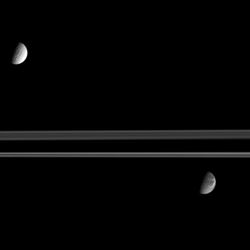
Tethys and Dione. Image credit: NASA/JPL/SSI. Click to enlarge.
Saturn’s expansive rings separate the moon’s Tethys (at the top) from Dione (at the bottom). Even in this distant view, it is easy to see that the moons’ surfaces, and likely their evolutionary histories, are very different.
Both moons are on the far side of the rings in this scene, which shows their Saturn-facing hemispheres (terrain centered on 0 degrees longitude). The dark shadow across the rings is cast by Saturn’s southern hemisphere.
The diameter of Tethys is 1,071 kilometers (665 miles) and the diameter of Dione is 1,126 kilometers (700 miles).
This image was taken in visible light with the Cassini spacecraft narrow-angle camera on Sept. 12, 2005, at a distance of approximately 2.4 million kilometers (1.5 million miles) from Saturn. The image scale is about 17 kilometers (11 miles) per pixel on the two moons.
The Cassini-Huygens mission is a cooperative project of NASA, the European Space Agency and the Italian Space Agency. The Jet Propulsion Laboratory, a division of the California Institute of Technology in Pasadena, manages the mission for NASA’s Science Mission Directorate, Washington, D.C. The Cassini orbiter and its two onboard cameras were designed, developed and assembled at JPL. The imaging operations center is based at the Space Science Institute in Boulder, Colo.
For more information about the Cassini-Huygens mission visit http://saturn.jpl.nasa.gov. The Cassini imaging team homepage is at http://ciclops.org.
Original Source: NASA/JPL/SSI News Release
